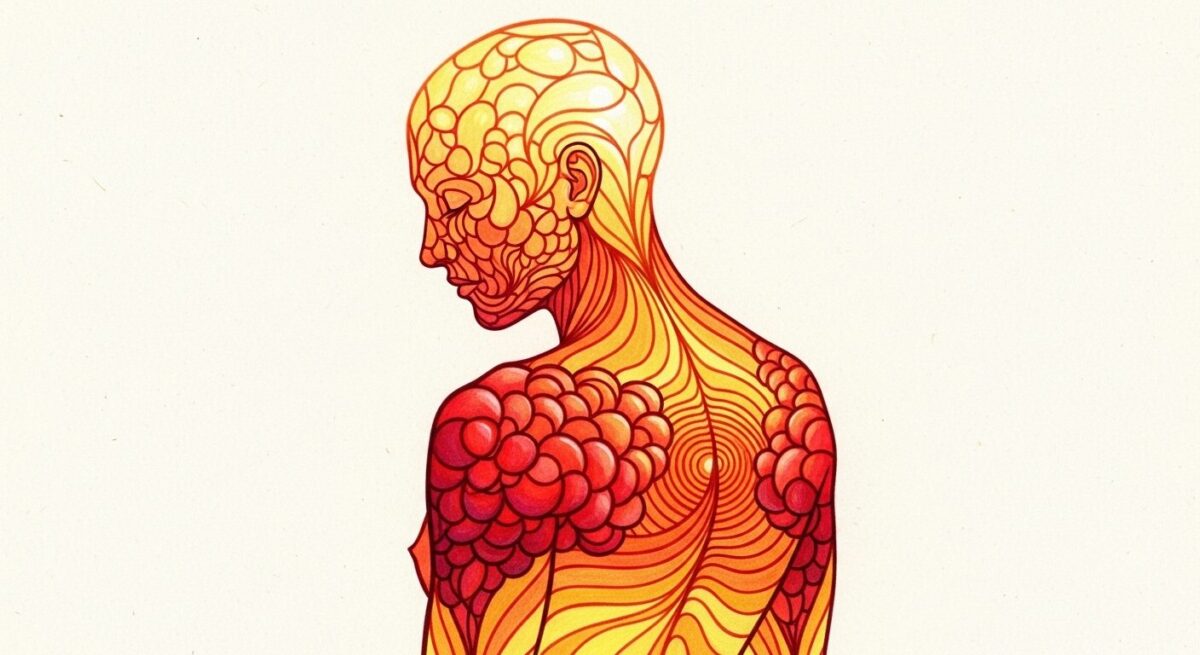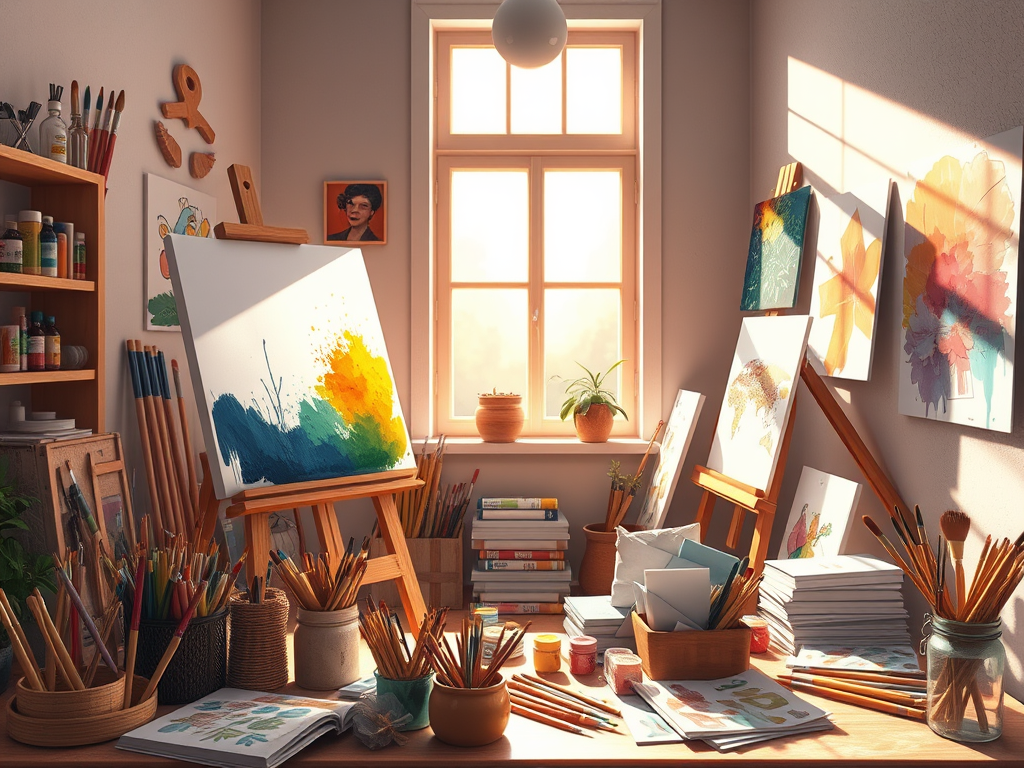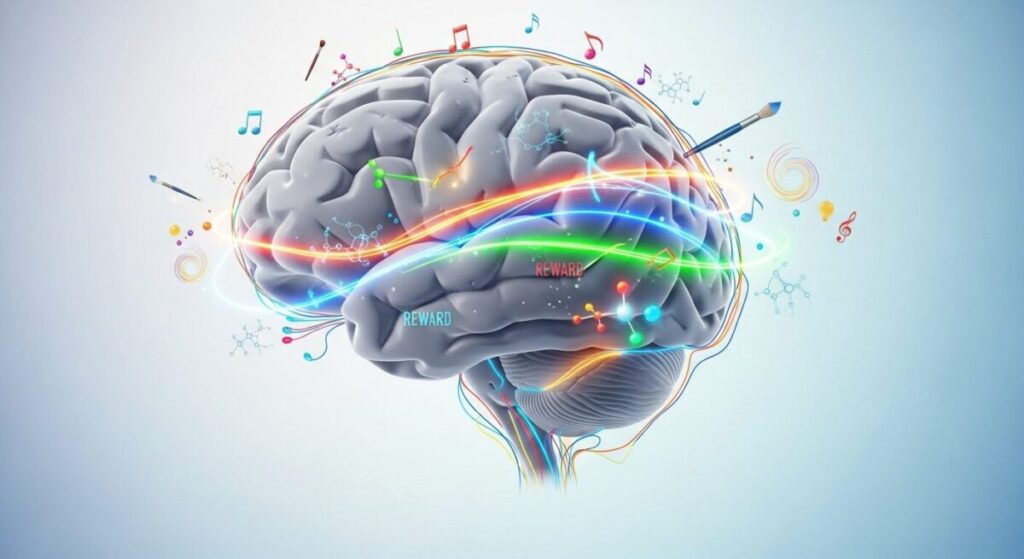Life can be stressful, and finding healthy ways to manage that stress is more important than ever. One powerful solution that’s gaining recognition from researchers and mental health professionals is mindful art forms for stress relief. These creative practices combine the calming benefits of mindfulness with the expressive power of art, offering a natural and effective way to reduce anxiety, improve mood, and find inner peace.
Key Points Summary:
- Drawing and doodling require minimal materials but provide maximum stress relief benefits
- Structured techniques like mandalas and zentangles help focus the mind and reduce anxiety
- Expressive painting allows emotional release through color and movement
- Scientific research confirms that art-making significantly reduces cortisol (stress hormone) levels
- Anyone can benefit – no artistic skill or experience required
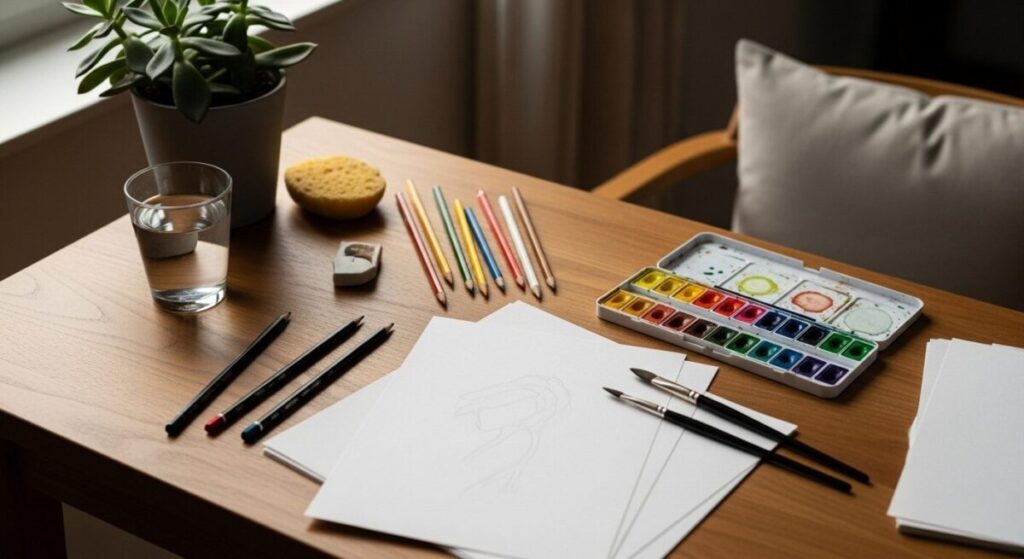
The Science Behind Art and Stress Relief
Recent research shows that art-making has a measurable impact on stress reduction. Studies have found that most people who try art as a form of therapy experience significant reductions in their cortisol levels – the hormone your body produces when stressed. Research from 2024 provides compelling evidence that art-making has the potential to foster positive personal development and significantly reduce stress levels among college students.
But why does creating art work so well for stress relief? When you’re focused on making art, your brain shifts into what psychologists call a “flow state.” This is similar to meditation, where your mind becomes fully absorbed in the present moment, pushing away worries about the past or future.
“Art is a natural way to practise mindfulness. The colors, textures, and sounds of creating pull us into the moment. You don’t need any previous training to meditate through art, just a willingness to draw like a child, with freedom and a sense of curiosity.”
Drawing and Doodling: Your Gateway to Calm
The Foundational Practice
Drawing is probably the most accessible form of mindful art. All you need is a pencil and paper, and you’re ready to start your journey toward stress relief. The simple act of making marks on paper helps anchor your attention in the present moment, creating a natural form of meditation.
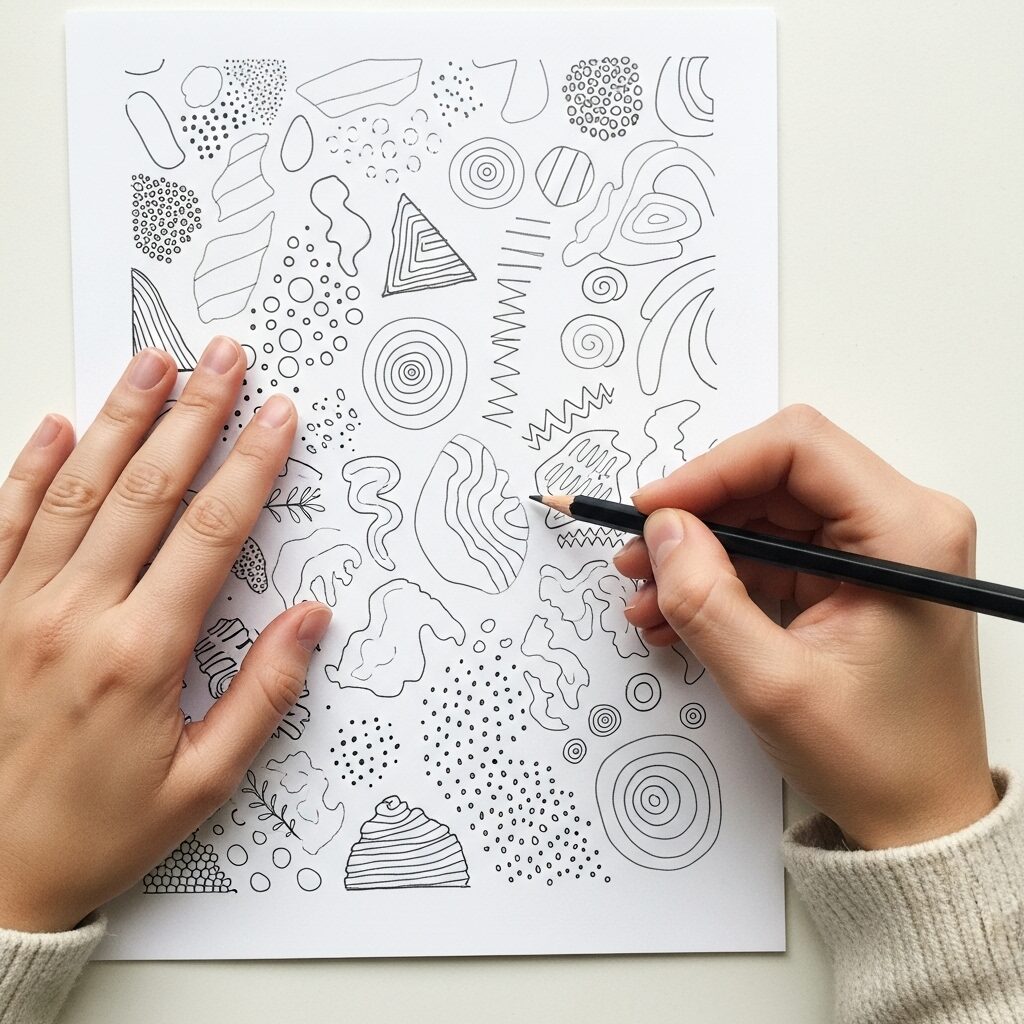
Benefits of Drawing for Stress Relief:
| Benefit | How It Works |
|---|---|
| Immediate Calm | Focuses mind on present moment |
| Emotional Release | Provides non-verbal outlet for feelings |
| Improved Focus | Trains attention and concentration |
| Reduced Anxiety | Slows racing thoughts and worries |
| Better Sleep | Calms nervous system before bedtime |
To draw mindfully, focus your attention fully on the act of drawing. Notice the movement of your hand, the feel of the pencil, and the texture of the paper. Don’t worry about creating something “good” – the process is what matters, not the final result.
Structured Techniques for Maximum Calm
Mandalas: Circles of Serenity
Mandalas are circular designs with repeating patterns that have been used for centuries as meditation tools. The word “mandala” comes from Sanskrit and means “circle” or “center.” When you create or color mandalas, the repetitive patterns help quiet your mind’s chatter.
How to Create a Simple Mandala:
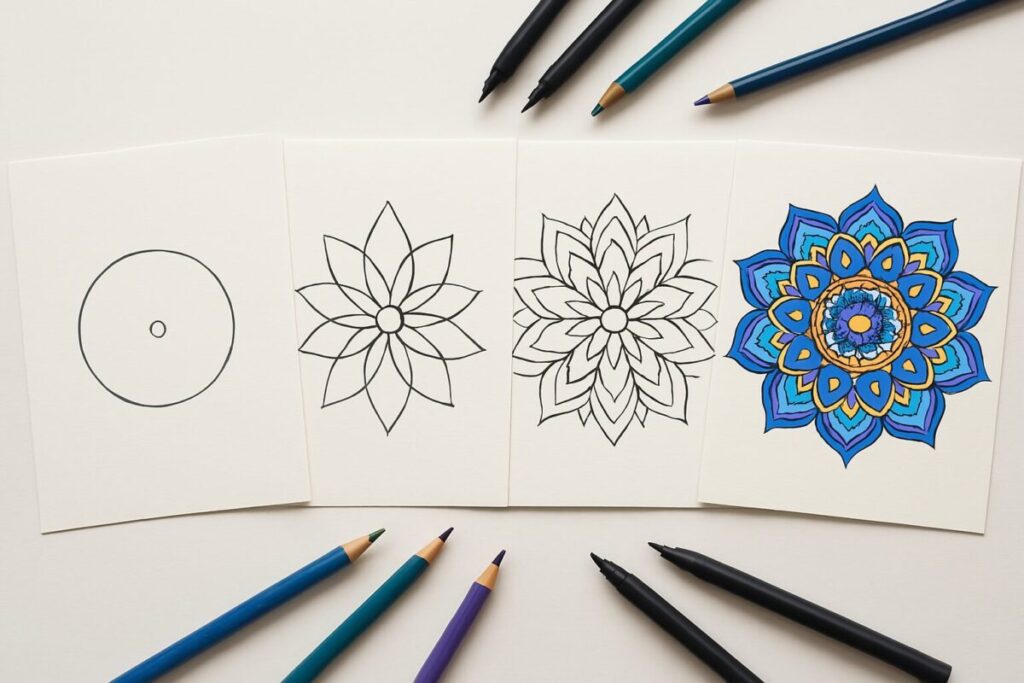
- Start with a dot in the center of your paper
- Draw a circle around it
- Add geometric shapes, lines, or patterns radiating outward
- Continue building layers, keeping everything balanced
- Focus only on the next mark you’re making
Research shows that coloring mandalas can be significantly more effective at reducing anxiety than free-form drawing because the structure gives your mind something specific to focus on.
Zentangles: Patterns for Peace
Zentangle is a specific method of drawing that uses simple, repetitive patterns called “tangles.” These patterns are drawn within a small square (usually 3.5 inches), making it a perfect practice for beginners.
Basic Zentangle Steps:
- Draw a border around your square
- Add a few curved lines to divide the space
- Fill each section with different repetitive patterns
- Focus on one stroke at a time
- No erasing allowed – embrace “mistakes” as part of the design
The beauty of zentangles is that there’s no wrong way to do them. Each “mistake” becomes part of the unique design, teaching you to accept imperfection and let go of perfectionist stress.
Neurographic Art: Healing Through Lines
This newer technique involves drawing a continuous, meandering line on paper and then mindfully rounding all the sharp intersections. This practice promotes mindfulness and helps dissolve stress with each stroke.
Try This Simple Neurographic Exercise:
- Think of something that’s causing you stress
- Let that feeling guide your hand as you draw a continuous, flowing line
- When lines cross, round off the sharp corners
- Continue until the drawing feels complete
- Notice how the stress feeling has changed
The Expressive Power of Painting
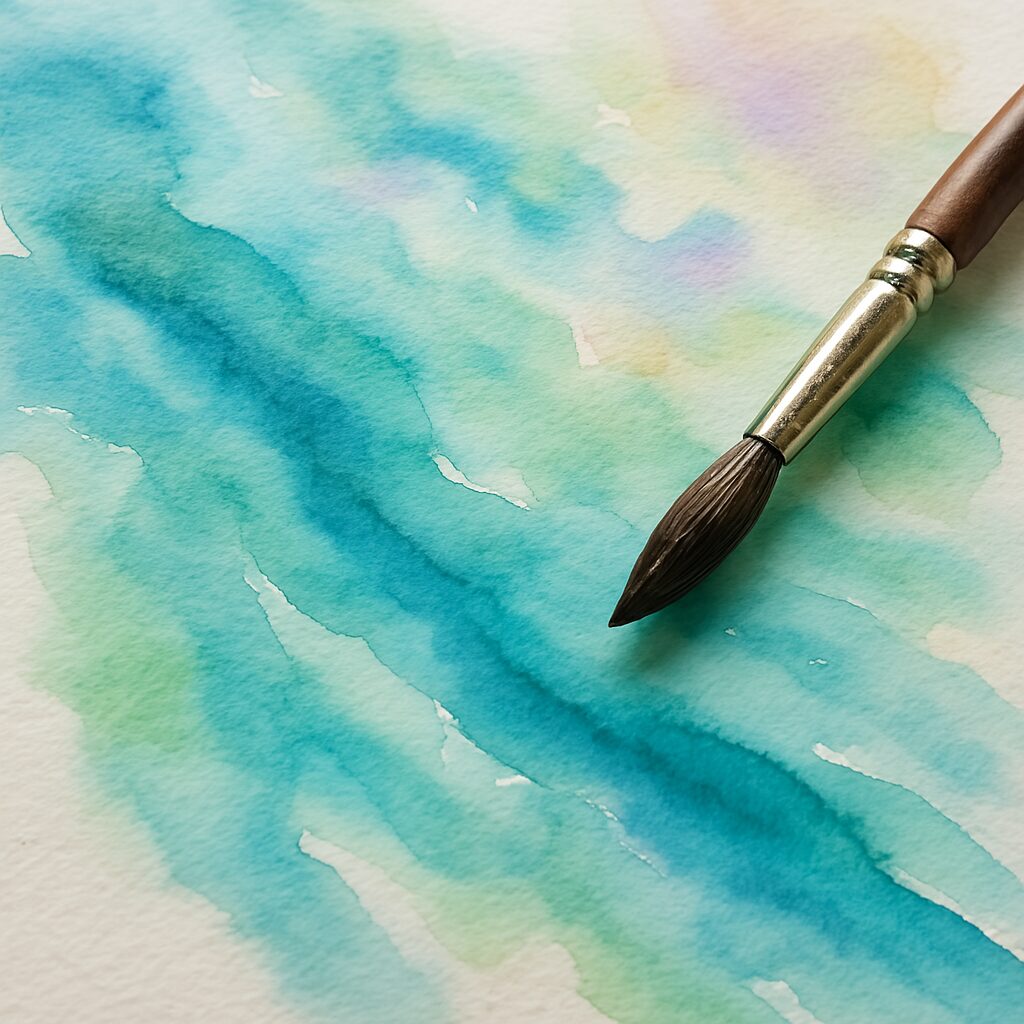
While drawing uses minimal materials, painting opens up a whole new world of sensory experience and emotional expression. The fluid nature of paint, especially watercolors, encourages letting go of control – a key element in stress relief.
Mindful Painting Techniques
Paint Your Breath:
- Choose colors that feel calming to you
- As you inhale, load your brush with paint
- As you exhale, make a brushstroke
- Continue this rhythm, painting in sync with your breathing
Emotion Painting:
- Select colors that match how you’re feeling right now
- Don’t try to paint a specific object
- Let the emotion guide your brush movements
- Fast strokes for anger, soft strokes for sadness, flowing strokes for peace
Paint to Music: This technique combines two powerful stress-relief methods. “Art provides a focus – like a mantra or awareness of the breath moving in and out of the body. Creating art helps me to access a meditative state”.
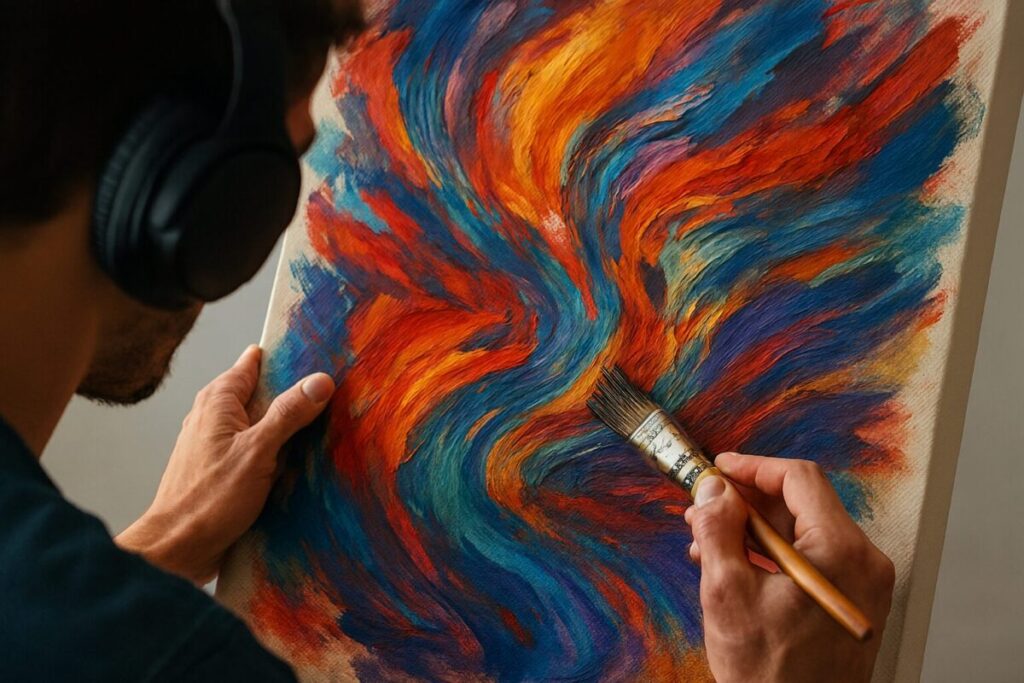
Choose instrumental music and let the rhythm guide your brushstrokes. Fast music might inspire quick, energetic marks, while slow music could lead to gentle, flowing movements.
Getting Started: Your First Mindful Art Session
What You’ll Need:
- Basic supplies: Paper, pencils, colored pencils, or basic watercolors
- Quiet space: Somewhere you won’t be interrupted
- Open mind: Remember, this isn’t about creating masterpieces
Setting Up for Success:
- Choose your time: Many people find 15-20 minutes ideal for beginners
- Prepare your space: Good lighting and comfortable seating help you focus
- Set an intention: Decide to be present and non-judgmental
- Start simple: Begin with basic doodling or simple patterns
“The goal isn’t to become an artist. The goal is to let art become a pathway to peace, self-discovery, and stress relief.”
Art Therapy Specialist
Advanced Techniques for Deeper Relief
Drawing Your Stressors
This powerful technique involves creating a visual representation of what’s causing you stress, then physically destroying or transforming that drawing. It provides a sense of control and release that can be incredibly therapeutic.
Steps for Stress Drawing:
- Think about your main source of stress
- Draw it however it appears in your mind (literal or abstract)
- When complete, you can:
- Scribble over it vigorously
- Tear it into small pieces
- Transform it into something beautiful by adding positive elements
Body Scan Art
After a body scan to identify tension, doodle your feelings using abstract shapes or patterns. This technique enhances body awareness and promotes inner calm.

Building Your Mindful Art Practice
Creating a Daily Routine
Morning Pages: Start your day with 10 minutes of free-flowing drawing or doodling Lunch Break Art: Use part of your lunch break for a quick mandala or zentangle Evening Wind-Down: End your day with calming watercolor washes or gentle sketching
Tracking Your Progress
Keep a simple art journal where you note:
- How you felt before creating art
- What technique you used
- How you felt afterward
- Any insights or thoughts that came up
You’ll likely notice patterns in what techniques work best for different types of stress or moods.
Common Challenges and Solutions
“I Can’t Draw”
This is the most common concern, but it’s based on a misunderstanding. Mindful art isn’t about creating something beautiful – it’s about the process of creating. Every mark you make is perfect for stress relief purposes.
“I Don’t Have Time”
Even five minutes of doodling can provide stress relief benefits. Try keeping a small sketchbook with you for moments when you’re waiting or feeling overwhelmed.
“My Mind Won’t Quiet Down”
This is normal, especially when starting. When thoughts intrude, simply notice them and gently return your attention to your art. Think of wandering thoughts as clouds passing through the sky of your mind.
The Long-Term Benefits
Regular practice of mindful art forms can lead to:
- Improved emotional regulation: Better ability to manage difficult emotions
- Enhanced creativity: Increased problem-solving skills in daily life
- Better self-awareness: Deeper understanding of your thoughts and feelings
- Reduced anxiety: Lower baseline levels of worry and stress
- Improved focus: Better concentration in work and relationships
Creative arts interventions have a positive impact on perceived stress and stress management. They reduce anxiety levels and improve subjects’ mood.
Frequently Asked Questions
Q: Do I need expensive art supplies to get started?
A: Not at all! A pencil and paper are enough to begin. As you develop your practice, you can gradually add colored pencils, markers, or basic watercolors.
Q: How often should I practice mindful art for stress relief?
A: Even 10-15 minutes a few times per week can be beneficial. Daily practice will provide the most significant benefits, but start with what feels manageable.
Q: Can children benefit from mindful art techniques?
A: Absolutely! Children naturally create art mindfully. These techniques can help kids manage big emotions and develop healthy coping strategies.
Q: What if I don’t feel relaxed while creating art?
A: Sometimes art brings up emotions or memories. This is normal and can be part of the healing process. If you consistently feel distressed, consider working with an art therapist.
Q: Is digital art as effective as traditional art for stress relief?
A: While art making with physical art materials has been demonstrated to reduce stress, digital art making is also utilized in art therapy. Both can be effective, though many people find the tactile experience of traditional materials more grounding.
YouTube Video Recommendation
Mindful art forms for stress relief offer a practical, accessible, and scientifically-backed approach to managing life’s pressures. Whether you choose the simple pleasure of doodling, the structured calm of mandalas, or the expressive freedom of painting, you’re giving yourself a powerful tool for emotional well-being. Remember, the journey of using mindful art forms for stress relief is personal and unique to each individual – there’s no wrong way to find peace through creativity.
Additional Resources
- American Art Therapy Association – Professional organization with resources and certified therapist directory
- Mindfulness-Based Art Therapy Research – Latest scientific studies on art and stress relief
- National Institute of Mental Health – Comprehensive mental health resources and research
- Art Therapy Alliance – Educational resources and practitioner support
- Calm App Art Activities – Guided digital art exercises for mindfulness
Citations
- Cho, Y. (2022). Research on paint-centered art therapy effects on college students. Frontiers in Psychology. https://www.frontiersin.org/journals/psychology/articles/10.3389/fpsyg.2024.1324415/full
- Sage Neuroscience Center. (2022). Can Art Therapy Relieve Stress? https://sageclinic.org/blog/art-relieve-stress/
- Calm Blog. (2024). What is meditative drawing? 5 techniques to get started. https://www.calm.com/blog/meditative-drawing
- Lightly Sketched. (2024). 20 Mindfulness Art Activities. https://lightlysketched.com/2022/05/20/20-mindfulness-art-activities/
- Mindful Creative Muse. (2024). Simple Drawing Techniques for Anxiety. https://mindfulcreativemuse.com/blog/2024/1/9/simple-drawing-techniques-for-anxiety

